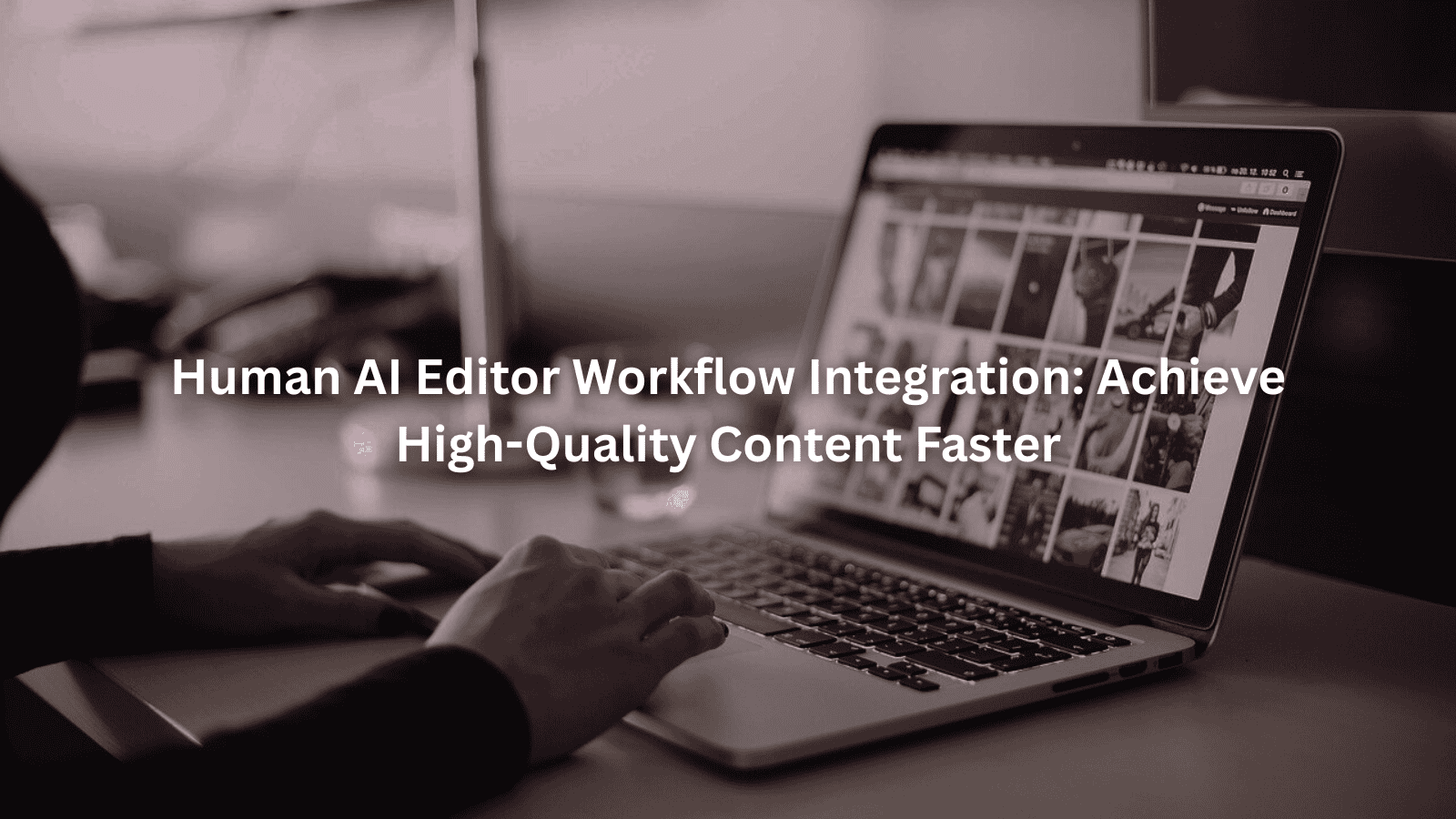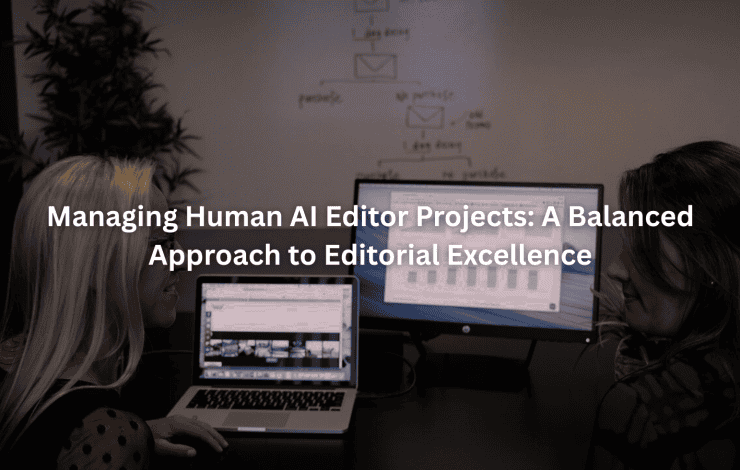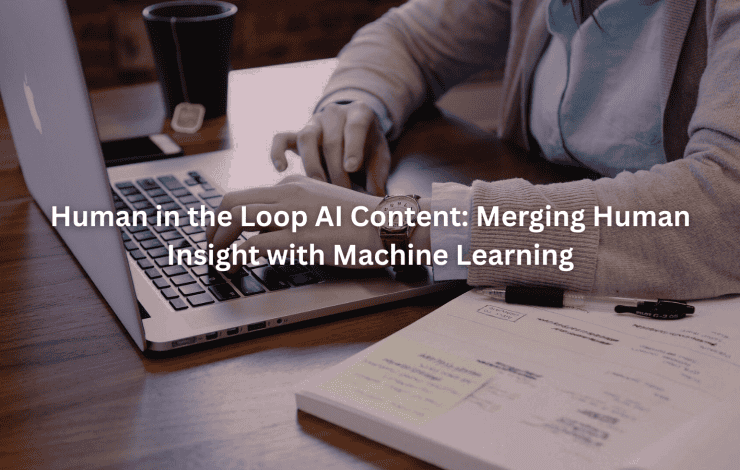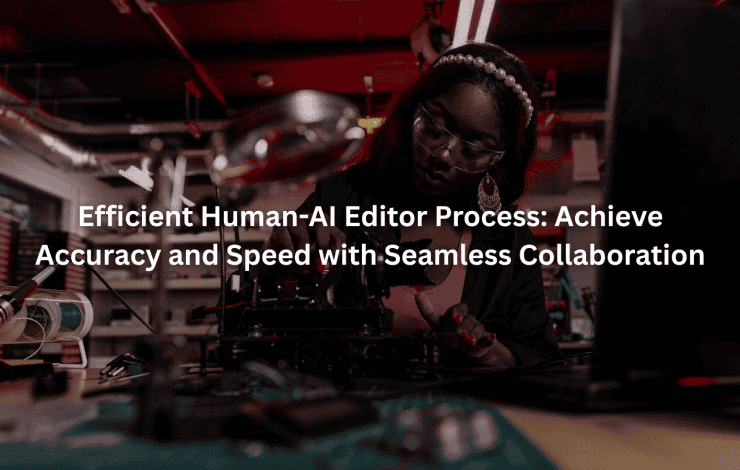AI’s great at cranking out words fast, no doubt about it. But content needs more than just words. It needs that special something that only comes from people who really get it.
Here at Jet Digital Pro, we found the sweet spot. We let computers do what they’re good at, all that first draft stuff that makes writers want to pull their hair out. Then our editors jump in. They fix things up. Make it real. Make sure everything’s true and makes sense to actual humans.
And guess what? The system works. We’re pushing out way more content now, but it’s not just quantity. It’s good. Really good. Because when it comes down to it, only people truly understand what other people want to read.
Key Takeaway
- Combining AI and human editors leads to faster, higher-quality content.
- Human oversight is critical for accuracy, brand voice, and compliance.
- A structured workflow (strategy, AI draft, human editing, approval) is essential for success.
Understanding Human AI Editor Workflow Integration
Writing’s changed a lot lately. At Jet Digital Pro, we watched it happen right in front of us. Started with just editors typing away. Then AI showed up. Now we do both, and honestly? It works better than either one alone, thanks to an integrated editorial process with AI and human editors.
Growing research shows that simply having AI outperform average human output is not enough, especially when stakes are high. Organizations are increasingly evaluating AI not just by average accuracy, but by its worst-case performance, because missing critical errors can be far more damaging than minor wins. [ 1 ]
Defining the Workflow
The secret’s in how you mix AI and people together. Not just taking whatever the AI spits out, not just having humans do everything either. It’s about knowing where each one shines. AI’s great at getting things started, humans are better at making it actually mean something.
Key Parts of Making It Work
- AI does the heavy lifting on first drafts
- Real editors polish everything up
- One central place where it all happens
- Everyone learns from what works and what doesn’t
Who Does What
AI handles the basics:
- Coming up with topics
- Writing first drafts
- Fixing obvious mistakes
People take care of the important stuff:
- Setting the right tone
- Making sure stories make sense
- Double checking facts
Why This Matters
We’ve seen this approach work in practice; it’s not just talk. The results speak for themselves.
Speed and Scale
AI is remarkably fast. We jumped on board, and just like that, our content output increased threefold overnight. It’s amazing to watch as it generates drafts, outlines, and ideas at lightning speed. This boost allows us to explore more topics and reach a wider audience without drowning in endless hours of manual work.
Getting Things Right
But speed only tells half the story. Our editors play a crucial role here. They are the guardians of quality, catching the quirky phrases and odd word choices that AI sometimes misses. It’s easy for machines to overlook subtleties, but our team makes sure that nothing embarrassing sneaks out into the world. Each piece gets thorough scrutiny, ensuring high standards are met at every turn.
Keeping Your Voice
AI can mimic different styles pretty well, but it doesn’t truly capture voice and authenticity. That’s where humans shine. Our editors know how to make a piece feel genuine and relatable. They weave in a personality that resonates with readers, bringing consistency throughout our content. This blend of speed from AI and the heartfelt touch of human editors results in stand-out writing that not only engages but also builds trust with the audience.
So, combining these elements is how we deliver content that’s not just efficient, but also real, relevant, and memorable.
Saving Money and Time
Smart combo means less waste. Editors spend time on what matters, not fixing comma splices. We’ve cut costs almost in half on some projects.
The whole thing just works better. Together. Like most good things in life.
Step-by-Step Editorial Workflow with AI Integration
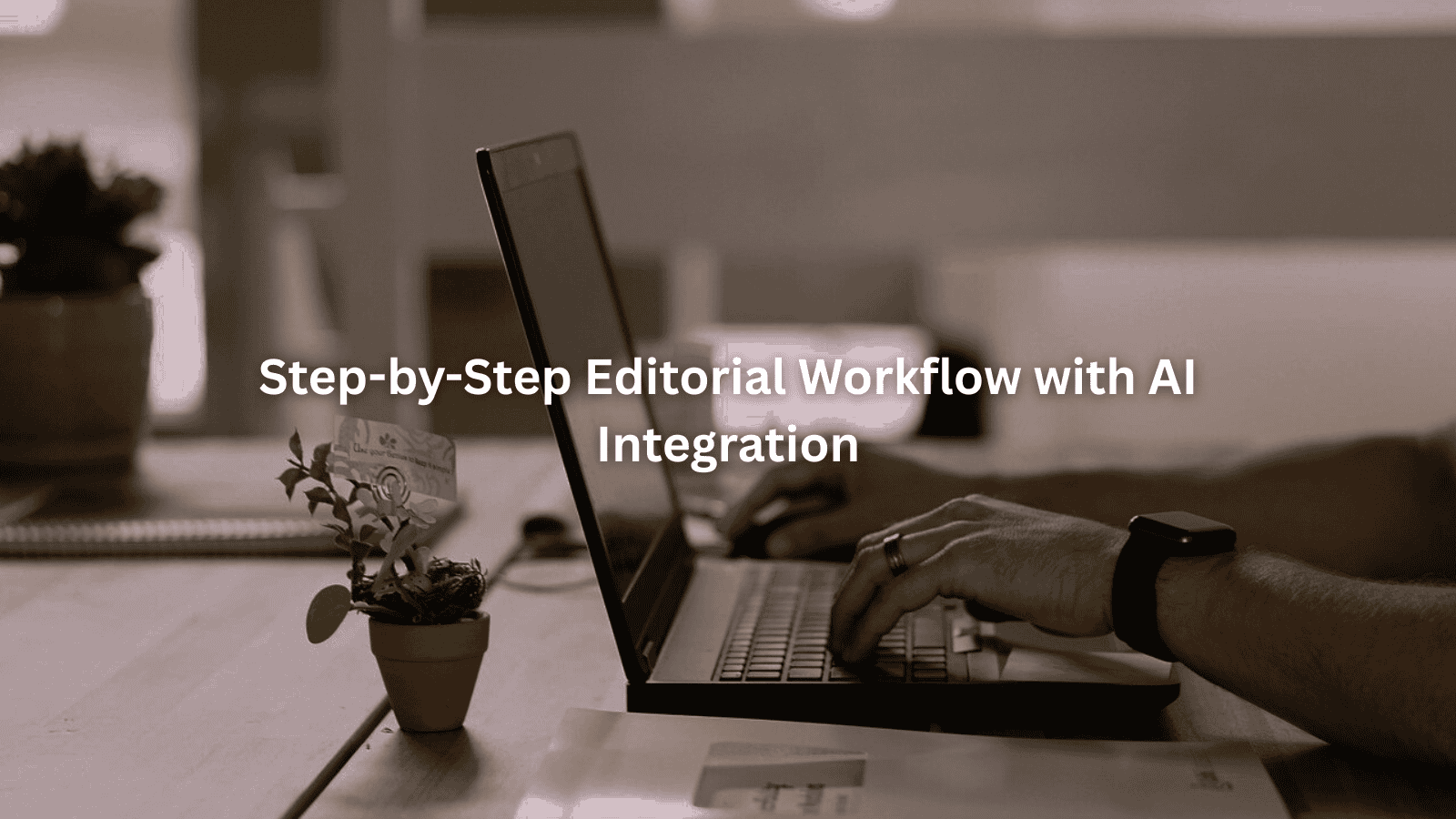
Listen, workflows aren’t set in stone. We’ve messed around with ours plenty, figured out what works. Here’s the real deal on how we do it.
Strategy & Briefing Phase
People come first, always. We hold quick meetings to nail down the basics. These discussions help clarify goals, expectations, and key details before diving into the work. Keeping communication open from the start sets the stage for a smoother process and better collaboration down the line. Quick meetings to nail down the basics:
Getting Started Right
- What are we trying to do here?
- Who’s gonna read this stuff?
- Keywords we gotta use?
- How should it sound?
Setting Up the AI
Grab some research. Look at what competitors are doing. Write clear instructions for the AI. Garbage in, garbage out, you know?
Coming Up With Ideas
AI’s pretty good at coming up with ideas. It can whip up suggestions faster than you can think of them. But don’t let it run wild. While it can be a useful jumping-off point, it’s important to keep a tight grip on the reins. Use AI’s ideas as a starting block, but sift through them with a discerning eye.
Find the concepts that actually fit what you’re after. Talk things over with peers or mentors, sometimes, a quick chat can spark a lightbulb moment. It’s all about collaboration.
Set some boundaries to keep brainstorming focused. This way, the process doesn’t go off the rails, and you end up with something that makes sense. In the end, remember: AI’s got its strengths, but it’s the human touch that brings the spark of originality and intent needed to make ideas truly shine.
First Round of Ideas
Let the computer spit out some headlines and topics. It usually gives plenty of options in just about a minute. Some might hit the mark, while others might miss it completely. The key is to keep an open mind and jot down everything that sparks interest. You never know when a simple phrase could lead to something bigger.
Making It Make Sense
Writing The First Draft
Getting Words on Paper
AI jumps in to write the rough draft. It gets a solid chunk of the work done, laying out the main ideas and structure. Sure, it’s not perfect, there may be awkward phrases or missing details, but it gives us a foundation to build on.
This initial draft is something tangible to work with and serve as a starting point. From here, we can refine the text, polish up the language, and add the necessary flair that makes it shine. It’s all about taking that first step and turning a rough idea into something more polished and engaging.
Making It Sound Right
Editors read through everything. Fix the weird parts. Make sure it sounds like actual humans wrote it.
Emerging studies signal a deeper nuance in creative collaboration: AI “co‑creation” (working alongside users) actually supports human creativity far more than scenarios where AI simply provides a draft that humans must edit. Users tend to produce better, more original content when they are in a co‑creator role, not just editors of AI output. [ 2 ]
Cleaning It Up
This is where it gets good. This is the part where it really starts to shine. The process can be messy, but that’s where the magic happens. An initial draft, full of thoughts and ideas, needs a keen eye to polish it into something truly effective.
Working Together
Use tracked changes. Sometimes the AI helps rewrite tricky spots. But editors make the calls, because what works best is working closely with both AI and human editors every step of the way.
Getting Facts Straight
Check everything. AI makes stuff up sometimes. Can’t have that. Verify everything. It’s crucial. AI has a reputation for making things up, sometimes inventing facts or details that don’t hold water. That’s a slippery slope. An editor’s diligence in checking information is non-negotiable.
Misinformation can lead to significant consequences, and it’s crucial to maintain credibility in any writing. So, double-check sources, cross-reference information, and ensure accuracy across the board. A reliable piece of writing stands up to scrutiny and reflects well on everyone involved.
Getting Content Right
Most folks can’t find good stuff online, even when they’re looking hard for it. Writers need to hit that sweet spot – easy enough for regular readers but still showing up in searches.
Making Sure Everything’s Legal
Nobody likes paperwork, but there’s no getting around the rules. Style guides might be boring, but they keep things straight. And yeah, having actual people check the legal parts beats hoping a computer got it right.
Getting Real Feedback
A writer’s first draft isn’t gonna be perfect (it never is). The magic happens when smart people take a look and point out what’s not working. Experts know their stuff, and clients know what they want – both matter.
The Last Push
Those final edits might feel like overkill, but they’re worth it. Double-checking links, fixing those weird spacing issues, making sure everything’s lined up right. Small stuff adds up.
Look, there’s no shortcut to doing this well. Some days the words flow, other days they don’t. But stick with it long enough, and you’ll start seeing what works. Pretty cool when it all comes together.
Integration Techniques and Tools

Getting the workflow right depends on having the right tools and routines.
Editorial Platforms Supporting Human-AI Collaboration
We use a single platform for all our projects. This system allows us to transfer drafts between AI and human editors effortlessly, ensuring that nothing gets lost in translation, context and comments stay intact throughout the process.
Centralized Systems for Seamless Editing Transitions
Everything we need is stored in one centralized location. No more endless email chains or frantic searches for lost files, which can waste valuable time. With everything in one place, it simplifies communication and keeps everyone on the same page. This organization leads to a smoother workflow and a more efficient editing process.
Workflow Automation and Visual Workflow Builders
We rely on drag-and-drop workflow builders that streamline our operations. Assigning tasks, setting deadlines, and bringing in editors or AI tools can all happen with just a click. This level of workflow automation not only speeds things up, it also reduces the chance of assignments falling through the cracks.
Quality Control and Feedback Mechanisms
Quality control isn’t a one-and-done deal. We believe in regular checks to maintain high standards. It’s not just about the initial draft; it’s about nurturing the content through its lifecycle. Routine evaluations allow us to catch any issues early and make necessary adjustments.
Establishing AI-Human Feedback Loops
Our editors play an essential role in evaluating AI outputs. They rate aspects like clarity, relevance, and tone, providing critical feedback. This input is vital for refining our prompts and improving AI performance over time. If something doesn’t resonate, we take note and make changes to ensure better results in the future.
Monitoring and Improving Content Quality Scores
We keep a rolling average of quality scores based on client feedback, readability, and accuracy. This ongoing assessment helps us identify trends. If the scores drop, we know it’s time to revisit our workflow to find out what went wrong and put solutions in place.
Scalability and Workflow Management
As our client list expanded, it became clear we needed effective ways to manage more content without sacrificing quality. Our platform helps us scale efficiently while maintaining integrity in our work.
Managing Workflow Nodes and Task Assignments
Each piece of content moves through specific “nodes”: draft, edit, review, and approve. These stages help keep everything organized. If one part of the process gets stuck, we can quickly reroute tasks to ensure that things keep moving forward. This flexibility is crucial for meeting deadlines and delivering top-notch content consistently.
Best Practices for Human-in-the-Loop Editing
- Always have a human review before publishing
- Rotate editors to prevent “blind spots”
- Use AI for drafts, but humans for headlines and calls-to-action
We’ve learned a few things along the way, like always having a human review before publishing, rotating editors, and letting AI handle low-context tasks. These real-world human-AI editing tips have helped us keep quality high even as we scale.
Enhancing Content Workflow with AI-Human Synergy
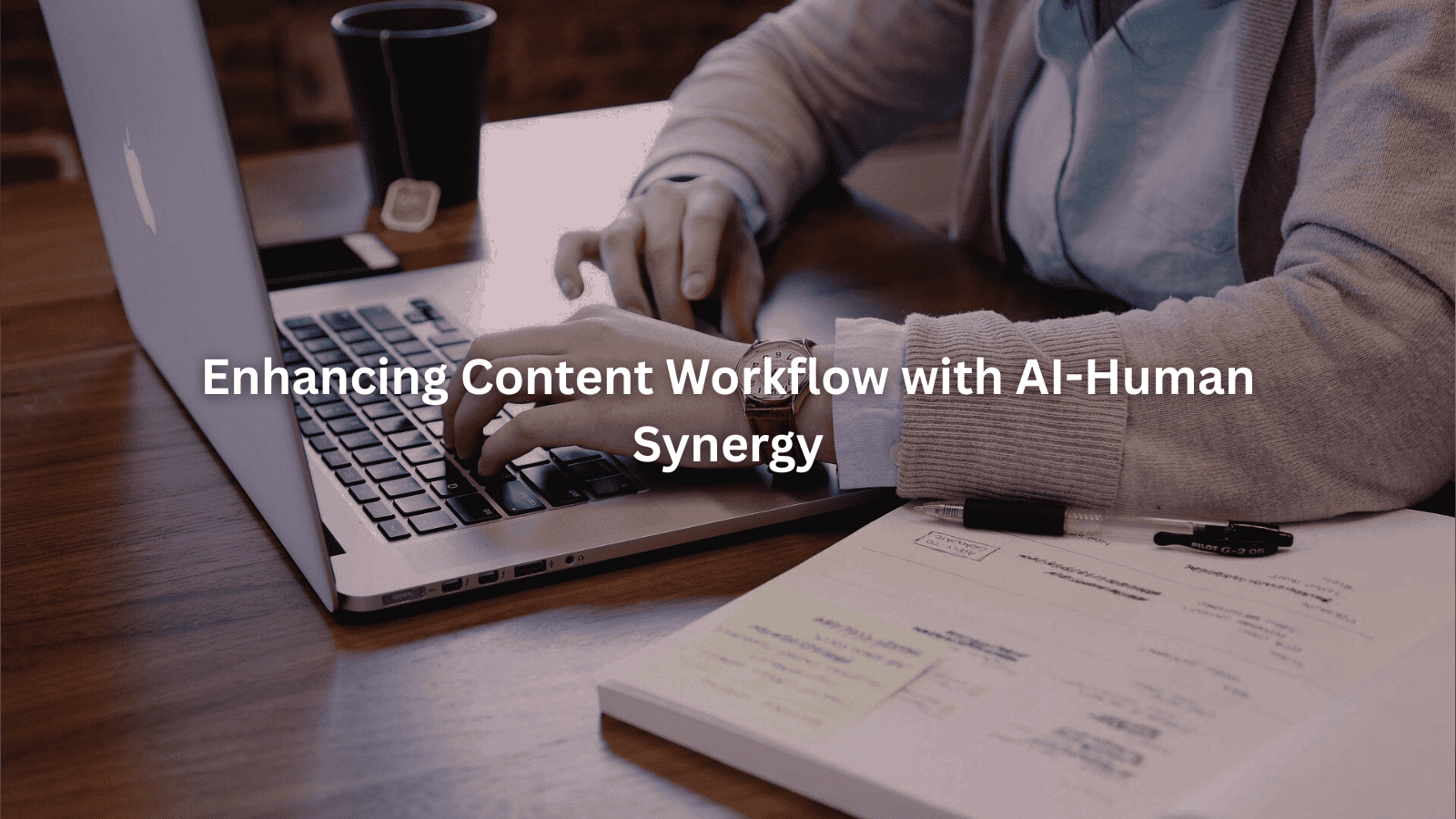
Are You a Digital Agency?
White Label SEO Content Services for Agencies
Scalable, customizable, and results-driven content solutions for your clients.
The best workflows play to the strengths of both AI and humans.
Strategic Role Definition for AI and Human Editors
We’ve clearly outlined our tasks to make the best use of both AI and human editors. AI handles high-volume, low-context work, like data processing and generating drafts, while humans focus on the creative, high-context editing. This division ensures that each side plays to its strengths: AI can churn out the numbers quickly, and humans can dive deep into nuance and tone. By defining these roles strategically, we create a more efficient workflow and elevate the overall quality of our content, making sure the right work gets the right attention at the right time.
Task Allocation Based on Strengths of AI and Humans
AI:
- Outlines
- Routine rewrites
- Data-driven summaries
Humans:
- Storytelling
- Sensitive topics
- Final polish
Maintaining Effective Human Oversight at All Stages
We set up regular checkpoints throughout the process. After each significant phase, a human editor must review and approve the work before we can move on. This ensures that nothing slips through the cracks and maintains the quality we aim for. It also allows for real-time feedback, helping to catch issues early on.
By keeping this system in place, we provide a solid safety net that reinforces our commitment to exceptional content. Everyone involved knows that their input matters and plays a key role in the final product’s success.
Optimizing Content Strategy with Analytics
Data shapes our workflow as much as intuition does. It’s not just about gut feelings; analytics play a critical role in how we craft our content and improve our processes.
Using Performance Data to Refine AI Prompts and Editorial Focus
We track which articles perform the best, diving into the metrics to uncover what resonates with our audience. This data becomes a crucial part of our strategy. We analyze engagement rates, shares, and reader feedback, feeding those insights back into our AI prompts.
When we see success with certain topics or tones, we instruct the AI to “write more like this, less like that.” This iterative process allows us to better align our content with audience preferences, creating a more tailored experience for our readers.
Continuous Improvement of Editorial Processes
Every few months, we sit down to review our statistics. These quarterly assessments are key to spotting bottlenecks in our workflow. Some areas might need more human intervention, while other times it might be necessary to retrain the AI.
It’s about finding that balance between automation and the human touch. Adjustments could involve reallocating resources or implementing new training protocols to keep everyone updated on best practices. By continuously improving our editorial processes, we ensure that our content remains relevant and engaging.
Ensuring Content Governance and Compliance
Writing for regulated industries brings a unique set of challenges, compliance is simply not optional. Every piece of content must adhere to strict guidelines to minimize risk and maintain integrity. This attention to governance isn’t just a box to check; it’s woven into our writing culture. We prioritize understanding the rules and the specific needs of these industries, ensuring that we deliver accurate and compliant content to our clients.
AI Editorial Compliance and Risk Mitigation
We train our AI extensively on compliance rules. While it’s a powerful tool, relying solely on it would be a risky move. The nuances of compliance standards can be complex, so we can’t trust the AI to catch every detail. Our approach balances leveraging AI capabilities with the human expertise needed to navigate the regulatory landscape. AI can help flag potential issues, but we always take the final step to ensure that it meets the necessary standards.
Human Review Checkpoints for Ethical and Legal Standards
The final review is an essential human checkpoint. Before any content goes live, it undergoes thorough scrutiny. This is where we check for copyright issues, fact accuracy, and potential bias. The ethics of our content can’t be overlooked, and we strive to uphold high standards in every piece. No article is published without this human review step.
Need a Strategic SEO Content Partner?
Let’s craft SEO content that ranks, converts, and grows your brand.
Talk to UsBy incorporating these meticulous processes, we create a safety net that not only enhances the quality of our content but also builds trust with our audience. In a world where misinformation can spread quickly, our commitment to accuracy and compliance sets us apart.
In summary, blending data-driven insights with human oversight, we navigate the complexities of our editorial landscape. Balancing the strengths of AI with the nuances of human judgment allows us to produce content that’s not just informative, but also ethical and engaging. It’s all part of our mission to make sure that every piece fulfills its purpose and meets the needs of our readers and clients alike.
Practical Advice
If there’s a single lesson from our experience at Jet Digital Pro, it’s this: don’t let the AI run wild, but don’t ignore its strengths, either. Use AI to multiply your output, but keep humans at the wheel for quality, compliance, and creativity. Start small, one workflow, one team, and build up as you learn what works. Document your process, gather feedback, and keep iterating.
For digital agencies, especially those scaling up or offering white-label SEO content, this approach is the only way to keep up with demand and still deliver content that stands out and passes AI detection. That’s how we’ve helped clients grow, by combining smart automation with the steady hand of skilled editors. If you want to see this in action, we’re always open to sharing what’s worked, and what hasn’t, in our own hybrid content production.
FAQ
How do you decide which editing tasks are better for AI versus humans?
We break down each task by complexity and context. If it’s something routine, like checking spelling, grammar, or formatting, AI tools can handle it well. But when the task calls for creativity, deep subject knowledge, or understanding subtle brand voice, we turn it over to our human editors. We’ve learned this balance through experience, adjusting as we see which tasks lead to the best results.
What’s the biggest challenge when mixing AI with human editing in a workflow?
One of the toughest issues is keeping the handoff smooth. Sometimes, AI-generated drafts can be off-topic or miss the tone we want, so human editors end up rewriting more than they expected. Communication between the AI “step” and the human “step” is key. We solve this by setting clear guidelines and tweaking prompts until we get results that need less fixing.
How do you track and improve the quality of content in a hybrid workflow?
We use a mix of scoring systems and editor feedback. Each piece is rated for clarity, accuracy, and tone, both by editors and, sometimes, by clients. If we notice certain kinds of errors repeat, we update our prompts or workflow rules. This lets us catch problems early and teach both the AI and our editors what works best.
How do you handle sensitive or regulated content in an AI-human workflow?
We never let AI publish sensitive or regulated content on its own. The AI can draft or suggest ideas, but a human editor must check every fact, citation, and statement for compliance with industry rules. For some clients, we even add an extra review layer before anything goes live. This double-checking keeps us out of trouble and protects our clients.
Can workflow integration with AI help small editorial teams, or does it only work at scale?
It actually helps small teams even more. With AI handling repetitive tasks, a lean staff can focus their time on creative edits and strategy. This means you can publish more without needing to hire extra people. We’ve seen small agencies double their output using this hybrid model, which makes it easier to compete with bigger companies.
Conclusion
Bringing AI and human editors together isn’t just efficient, it’s how we consistently deliver fast, accurate, and on-brand content at scale. At Jet Digital Pro, every workflow tweak reinforces this truth: AI handles the heavy lifting, but our 11-step human editing process keeps quality sharp and Google-ready.
If you’re a digital agency looking to grow without stretching your team thin, this hybrid model works. It’s how we help clients scale smart. Let’s talk content.
References
- https://fortune.com/2025/07/08/companies-want-ai-to-be-better-than-the-average-human-measuring-that-isnt-straightforward
- https://www.nature.com/articles/s41598-024-69423-2
Related Articles
- https://jetdigitalpro.com/integrating-human-ai-editors-into-workflow/
- https://jetdigitalpro.com/best-practices-for-human-ai-editing
- https://jetdigitalpro.com/collaborating-with-a-human-ai-editor
P.S – Whenever you’re ready,
we’re here to help elevate your SEO content.
Partner with us for strategic, scalable content that drives real organic growth.
Contact Us Now
